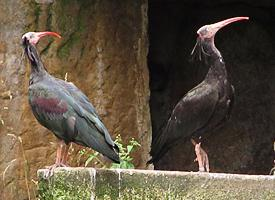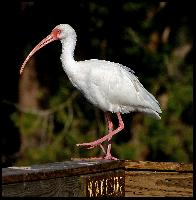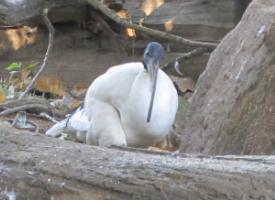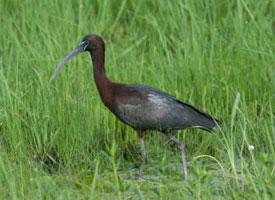
Váhy a míry
| Délka | od 70 do 80 cm |
|---|
Stav ohrožení
| Ohrožen |
Popis zvířete
The Northern Bald Ibis (Geronticus eremita), also known as the Hermit Ibis or Waldrapp, is a fascinating and highly distinctive bird species belonging to the Threskiornithidae family, which primarily includes ibises and spoonbills. This species is characterized by its unique appearance, intriguing behaviors, and a critically endangered status that has drawn significant conservation attention.Physical Description:
The Northern Bald Ibis stands out with its striking appearance. Adults typically measure about 70-80 cm in length, with a wingspan of approximately 125-135 cm, and weigh around 1-1.3 kg. One of its most notable features is the lack of feathers on its head and neck, which gives the bird its "bald" descriptor. The skin in these areas is a dark, dull red, contrasting sharply with its glossy, iridescent black plumage. Juveniles, however, possess a covering of down on their heads, which they lose as they mature. The bird's long, curved red bill is another distinctive characteristic, adapted perfectly for foraging. Their legs and feet are dark gray or black.
Habitat and Range:
Historically, the Northern Bald Ibis had a broad range that included parts of Europe, the Middle East, and North Africa. However, its range has drastically diminished, and it is now primarily found in semi-desert or arid mountainous regions of Morocco and, in smaller numbers, in Syria. These birds favor rocky cliffs, which offer ideal nesting sites, in close proximity to grasslands, agricultural fields, and river valleys where they forage.
Behavior and Diet:
Northern Bald Ibises are gregarious birds, often found in small flocks. They have a varied diet that includes a range of insects, small reptiles, and other small animals, which they hunt for in grasslands and fields using their long, curved bills to probe the soil. These birds are known for their strong social bonds, engaging in mutual preening and displaying loyalty to their nesting sites, which they return to year after year.
Reproduction:
Breeding season for the Northern Bald Ibis is typically from March to June. They are colonial nesters, with pairs building their nests on ledges of steep cliffs to protect their offspring from predators. A typical clutch consists of 2-3 eggs, which both parents incubate for about 24-25 days. The chicks are altricial, meaning they are born blind and without feathers, depending entirely on their parents for food and protection. They fledge around 7-8 weeks after hatching but remain dependent on their parents for a while longer.
Conservation Status:
The Northern Bald Ibis is classified as Critically Endangered by the International Union for Conservation of Nature (IUCN). Its population has suffered from hunting, habitat destruction, and pesticide use, leading to a drastic decline in numbers. Conservation efforts are ongoing and include habitat protection, anti-poaching measures, and captive breeding programs aimed at reintroducing birds into their historical range. International cooperation and community involvement have been pivotal in the recent stabilization and slight recovery of some populations, offering a glimmer of hope for this unique and ancient bird species.
Cultural Significance:
The Northern Bald Ibis holds significant cultural and historical importance in various human societies, depicted in ancient Egyptian hieroglyphs and revered in the Middle East as a symbol of fertility and virtue. Its decline has not only been a loss to biodiversity but also to cultural heritage, underscoring the multifaceted importance of its conservation.
Podobná zvířata
Nové fotografie zvířat
Top 10 zvířat
- Chinese water dragon (Physignathus cocincinus)
- Galápagos tortoise (Geochelone nigra complex)
- Dolphin gull (Leucophaeus scoresbii)
- Japanese macaque (Macaca fuscata)
- Colombian red howler (Alouatta seniculus)
- Sea urchins (Echinoidea)
- Moustached guenon (Cercopithecus cephus)
- Diana monkey (Cercopithecus diana)
- Common reed warbler (Acrocephalus scirpaceus)
- Common house mosquito (Culex pipiens)


